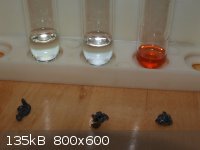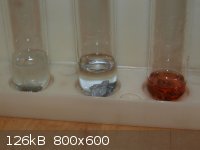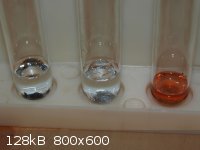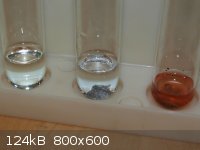| Pages:
1
2 |
blogfast25
International Hazard
    
Posts: 10562
Registered: 3-2-2008
Location: Neverland
Member Is Offline
Mood: No Mood
|
|
Dissolving cadmium metal in acid?
eBay UK offers some reasonably priced cadmium metal of good purity. I wouldn’t mind buying some for small experimentation (I’m aware of the
toxicity of cadmium salts and compounds).
Does anyone here have any practical experience with dissolving the metal in acids? Nitric acid seems the recommended solvent, dissolution in HCl and
H2SO4 being possible (going by textbooks) but slow.
Any practical experiences (concentration, temperature, quantities, method) with dissolving cadmium metal appreciated. Searching this forum didn’t
yield much.
|
|
|
MrHomeScientist
International Hazard
    
Posts: 1806
Registered: 24-10-2010
Location: Flerovium
Member Is Offline
Mood: No Mood
|
|
I could look into this for you. I got some cadmium metal for Christmas (my parents know me well!) so I can see how it behaves in HCl and dilute and
concentrated sulfuric acids. I don't have nitric acid at the moment, but I'm planning on making it in the coming weeks.
|
|
|
blogfast25
International Hazard
    
Posts: 10562
Registered: 3-2-2008
Location: Neverland
Member Is Offline
Mood: No Mood
|
|
That would be nice, Mr HS!
|
|
|
strontiumred
Harmless

Posts: 36
Registered: 6-7-2007
Location: Southern England
Member Is Offline
Mood: Delocalised
|
|
I've only tried it with cadmium powder.
I added 250mg of cadmium powder to 4ml of 10% hydrochloric acid and left it for 1 day. About 70% of the metal had dissolved and I was able to do some
experiments with the clear liquid. Adding sodium sulfide formed the intense yellow compound cadmium sulfide for example.
Maybe try this http://www.ebay.co.uk/itm/CADMIUM-METAL-SHAVINGS-Cd-99-95-Si...
Always had good experience with this seller.
[Edited on 13-2-2012 by strontiumred]
|
|
|
woelen
Super Administrator
        
Posts: 7976
Registered: 20-8-2005
Location: Netherlands
Member Is Offline
Mood: interested
|
|
I have experimented with cadmium as well. I managed to dissolve the metal in 20% HCl, but it takes a looooooong time. Just add a piece of the metal to
the acid and set aside in a loosely stoppered bottle. After a week or two, the metal will be "gone". Much quicker dissolving is possible if you use a
cadmium rod as anode in 20% HCl.
If you have powder, then it probably will take less time, but still expect a day or two before it has dissolved.
A better option is the oxide. I also purchased CdO (from the same seller as the one mentioned in the post just above), a brown powder. This dissolves
in acid very quickly and gives a clear solution. With that I did some of my experiments.
I must say though that cadmium is not the most appealing element to play with, especially if its toxicity is taken into account as well. Its aqueous
chemistry is mostly colorless, it has no aqueous redox chemistry (+2 is the only oxidation state) and nearly all of its precipitates are white or very
pale yellow (exceptions are the bright yellow sulfide and brown/red selenide).
|
|
|
LanthanumK
Hazard to Others
  
Posts: 298
Registered: 20-5-2011
Location: New Jersey
Member Is Offline
Mood: No Mood
|
|
Since cadmium has about the same electrode potential as iron, it probably dissolves in a similar way.
hibernating...
|
|
|
blogfast25
International Hazard
    
Posts: 10562
Registered: 3-2-2008
Location: Neverland
Member Is Offline
Mood: No Mood
|
|
Quote: Originally posted by woelen  | | I must say though that cadmium is not the most appealing element to play with, especially if its toxicity is taken into account as well. Its aqueous
chemistry is mostly colorless, it has no aqueous redox chemistry (+2 is the only oxidation state) and nearly all of its precipitates are white or very
pale yellow (exceptions are the bright yellow sulfide and brown/red selenide). |
I seem to have read there's a +I state, analogous to mercury.
Anybody try strong H2SO4?
|
|
|
hames
Harmless

Posts: 24
Registered: 14-2-2012
Location: oz
Member Is Offline
Mood: as was
|
|
I recently got some cadmium from the u.k and the first thing I did was make some cadmium nitrate.my nitric acid was very weak,about as weak as it
would get if you left it without a lid on it for year.
I chipped off a gram with a knife,thinking I would have to heat the acid to dissolve the metal I dumped the whole lot into 10ml of nitric in a test
tube and it instantly bubbled up and nox'd bigtime no heat required,I haven't tried sulphuric or hydrochloric acid yet but I would consider it very
reactive in nitric acid.
also I tried to dry out the cadmium nitrate but could only get it to a syrupy yellow goo,not that I tried too hard only a hot water bath for a few
hours so I just made a solution out of it.I ended up making a little bit of cadmium azide it seemed to yield poorly compared to the lead salt it also
required refrigeration to precipitate out of solution,I don't want to mess with many of its soluble compounds because it's carcinogenic.
|
|
|
plante1999
International Hazard
    
Posts: 1936
Registered: 27-12-2010
Member Is Offline
Mood: Mad as a hatter
|
|
I suppose strong H2SO4 react readily with cadmium when hot, similar to Hg reaction with concentred, hot H2SO4.
Cadmium is more similar to Hg than Zn from wath I read.
I never asked for this.
|
|
|
blogfast25
International Hazard
    
Posts: 10562
Registered: 3-2-2008
Location: Neverland
Member Is Offline
Mood: No Mood
|
|
Cadmium nitrate is deliquiescent, so hard to isolate with ordinary means.
I'd like to try strong H2SO4 and convert the sulphate to carbonate: that way you have a solid, stable source of acid soluble cadmium salt when you
want to use it.
|
|
|
woelen
Super Administrator
        
Posts: 7976
Registered: 20-8-2005
Location: Netherlands
Member Is Offline
Mood: interested
|
|
I also have the idea that the ease with which cadmium dissolves strongly depends on the purity of the metal. I have a very pure sample (99.99% or so).
I have a very similar experience with tin. I have 99.99% tin and this only dissolves in acid with great difficulty. I also have less pure tin (around
99%) and this dissolves more easily. Maybe the same is true for cadmium. Someone with multiple samples of cadmium of different purity could try it.
In theory, cadmium indeed can have a +1 oxidation state (as Cd2(2+) ions), but as far as I know this is not in aqueous solution. Anyway, the Cd2(2+)
ion is VERY unstable and its stability differs a lot from the stability of the Hg2(2+) ion. I do not expect that you will be able to make Cd2(2+) ions
in your aqueous solutions.
|
|
|
blogfast25
International Hazard
    
Posts: 10562
Registered: 3-2-2008
Location: Neverland
Member Is Offline
Mood: No Mood
|
|
woelen:
It's certainly a possibility: my car battery lead is more resistant to nitric than my pure (99.9 %). For tin I found the 99.9 % sample to dissolve
fairly easily in hot 35 % HCl: not fast but really doable.
|
|
|
plante1999
International Hazard
    
Posts: 1936
Registered: 27-12-2010
Member Is Offline
Mood: Mad as a hatter
|
|
I will again speak about titanium but... It is in contex scince I experienced similar thing with it.
Titanium industrial grade 1 is realy soft and disolve in HCl somewath easily.
Titanium industrial grade 5 is realy hard and disolve hardly in boiling HCl.
Source: My own work.
[Edited on 15-2-2012 by plante1999]
I never asked for this.
|
|
|
MrHomeScientist
International Hazard
    
Posts: 1806
Registered: 24-10-2010
Location: Flerovium
Member Is Offline
Mood: No Mood
|
|
I started the cadmium acid comparison test tonight, here are some initial photos.
From left to right:
0.4g Cd metal, 2mL 9.5M HCl
0.4g Cd metal, 2mL 4.4M H<sub>2</sub>SO<sub>4</sub> (battery acid grade)
0.5g Cd metal, 1mL 18M H<sub>2</sub>SO<sub>4</sub> (Liquid Fire drain cleaner)

I placed these in the acids and loosely stoppered each test tube. Just a few minutes afterwards, a steady stream of bubbles is flowing from the one in
HCl. Some small bubbles are adhering to the piece in dilute H<sub>2</sub>SO<sub>4</sub>, with similar results plus a small
stream of bubbles barely visible in the conc. H<sub>2</sub>SO<sub>4</sub>.

I'll leave these overnight and see how they look tomorrow!
|
|
|
blogfast25
International Hazard
    
Posts: 10562
Registered: 3-2-2008
Location: Neverland
Member Is Offline
Mood: No Mood
|
|
Thanks, Mr HS, that seems pretty convincing already as it is. Try perhaps also to put them on a steam bath, just to see the effect of temperature?
|
|
|
MrHomeScientist
International Hazard
    
Posts: 1806
Registered: 24-10-2010
Location: Flerovium
Member Is Offline
Mood: No Mood
|
|
Here are the tubes after 24 hours in the acids.

HCl (left) looks to be 3/4 dissolved, while the other two are slow going. Some bubbles adhering to the dilute sulfuric (middle), but no visible change
is size, though it is shinier. The conc. sulfuric (right) has some tiny bubbles, but seems to be coated in a white material. I'd wager that this is
cadmium sulfate that formed, but had no water to dissolve in. I bet if I diluted it, it would pick up a bit.
I'll try to do the heating experiment tomorrow night, but I'm not sure if I'll have time. I'm going on a trip this weekend, so I need to pack and if I
don't get time it'll need to wait until I return. But yes indeed, it looks like dissolving Cd in acid is slow regardless of which one you use.
|
|
|
blogfast25
International Hazard
    
Posts: 10562
Registered: 3-2-2008
Location: Neverland
Member Is Offline
Mood: No Mood
|
|
Thanks Mr HS, quite useful!
|
|
|
MrHomeScientist
International Hazard
    
Posts: 1806
Registered: 24-10-2010
Location: Flerovium
Member Is Offline
Mood: No Mood
|
|
No problem - glad to help!
After 48 hours now in the acids, here is the situation:

The HCl has nearly completely dissolved the Cd, only a few tiny black flakes remain. Dilute sulfuric still isn't doing much, and conc. sulfuric is
about the same as well. I shook the conc. sulfuric tube around and the white coating on the metal is definitely Cd sulfate precipitate.
I also did a quick trial heating both sulfuric solutions with my butane burner for a minute or so. This sped up bubbling in the dilute sulfuric
somewhat, but it's hard to say whether that was the reaction or just the water starting to boil. Heating the conc. sulfuric, however, very noticeably
speeds things up. A constant stream of small bubbles started up from the metal, where no bubbles at all were visible before.
I'd guess that diluting the conc. acid somewhat to allow the precipitate to dissolve and get out of the way, as well as heating the solution, would be
the way to go if you want cadmium sulfate from the metal.
I'll let you know if anything interesting happens in a few days.
|
|
|
blogfast25
International Hazard
    
Posts: 10562
Registered: 3-2-2008
Location: Neverland
Member Is Offline
Mood: No Mood
|
|
Very helpful. Strange about the CdSO4: that's supposed to be highly soluble too...
|
|
|
saturnrox
Harmless

Posts: 2
Registered: 18-2-2012
Member Is Offline
Mood: No Mood
|
|
I mean no offence, but how do you people dispose of the Cd salts you make. I for one do not ever dispose heavy metal salts, even copper or zinc or
iron salts, when they are soluble. I make them insoluble by reacting with excess carbonate and then either extract the carbonate (filtration) or then
throw it away. But you guys are messing with some serious stuff here, and the method I outlined still wouldn't make your disposal of cadmium safe. So
just wondering, for the sake of your health and our environment, just how do you dispose of such a toxic heavy metal?
A stock broker at Wall Street could earn well over 10 million dollars a year by contributing literally nothing to society, while a scientist searching
for the cure of cancer would be lucky to earn 80000 dollars in the same period. Society must change.
|
|
|
blogfast25
International Hazard
    
Posts: 10562
Registered: 3-2-2008
Location: Neverland
Member Is Offline
Mood: No Mood
|
|
Quote: Originally posted by saturnrox  | | But you guys are messing with some serious stuff here, and the method I outlined still wouldn't make your disposal of cadmium safe.
|
Have you noted the quantities of cadmium used in Mr HS's experiments? They are practically minute.
|
|
|
saturnrox
Harmless

Posts: 2
Registered: 18-2-2012
Member Is Offline
Mood: No Mood
|
|
Yes, the quantities are minute, but that does not eliminate our responsibilities as home experimentalists to dispose of it in an appropriate manner.
My question was not WHY you play with the Cd, I totally understand that, or even how much it is you use. I am just curious on HOW to dispose of any
dangerous metal I might use safely. Just because a toxic chemical, lets say like chromium(VI), is used in small quantities doesn't mean we can dispose
of it as we chose fit, because in the end of it all we owe whatever we are doing to the people around us and to our planet, and should appreciably
take an effort to minimize or eliminate any damage that may result to the environment. Hope you get
my point  . Just asking 'how' do you guys dispose of such things. . Just asking 'how' do you guys dispose of such things.
A stock broker at Wall Street could earn well over 10 million dollars a year by contributing literally nothing to society, while a scientist searching
for the cure of cancer would be lucky to earn 80000 dollars in the same period. Society must change.
|
|
|
Arthur Dent
National Hazard
   
Posts: 553
Registered: 22-10-2010
Member Is Offline
Mood: entropic
|
|
@ saturnrox:
I completely understand your point of view and agree with it somehow, but the typical home experimenter is not a major source of heavy metal
contamination. Imagine that the typical derelict cathode ray tube monitor which gets sent to the landfill daily contains sometimes half a pound of
lead, and most e-junk contains nickel, cadmium, barium, chromium, mercury and many other nasties. I think that many of the regular household waste
generates more toxic compounds that we will ever do with out test-tube full of reagents.
Doesn't make it any more right but I think that any heavy metal in minute quantity and in an insoluble form should be considered safe for regular
disposal. And I emphasize minute quantities... I wouldn't go and dissolve 500g of cadmium knowing that at the end of the experiment, i would dispose
of a large quantity of it because as an experimenter, that's not what I would do for any reason.
Anyone who wishes to go "by the book" and dispose of hazardous chemicals according to regulation would have a hard time going to the recycling plant
and explaining "here's a half pound of mercury chloride i've used to perform a Barbier reaction"... On the other hand, there are occasional "hazardous
products" collections at the municipal level where you can dispose of stuff you're not comfortable with, like old acids or contaminated solvents.
But all in all, unless you use chemistry as a business and generate large amounts of hazardous waste, I don't think we should lose sleep over a few mg
of chemicals here and there if they have been properly neutralized.
Robert
--- Art is making something out of nothing and selling it. - Frank Zappa ---
|
|
|
blogfast25
International Hazard
    
Posts: 10562
Registered: 3-2-2008
Location: Neverland
Member Is Offline
Mood: No Mood
|
|
Arthur is correct of course: size is everything here. If that was not the case then most home experimenting with chemistry would be subject to severe
restrictions from a environmental protection viewpoint.
|
|
|
woelen
Super Administrator
        
Posts: 7976
Registered: 20-8-2005
Location: Netherlands
Member Is Offline
Mood: interested
|
|
I solve this problem of toxic waste by keeping a bottle in my lab, in which I pour very toxic stuff like the cadmium waste. A one liter bottle goes a
long time. I only pour in the really toxic stuff, like mercury salts, cadium salts, lead salts and also stuff like antimony, arsenic, tellurium and
selenium. If I use somewhat larger quantities of less toxic (but still toxic) metals like nickel, copper, cobalt, molybdenum, then these also go into
the bottle. Small quantities of moderately toxic metal salts (in the order of magnitude of 100 mg) I just dilute and rinse away with a lot of water.
When the one liter bottle is nearly full, I bring it to a municipal waste processing facility and I tell that it is photography darkroom waste. I
label the bottle with the words "Heavy metal waste". A one liter bottle goes for well over one year, maybe even two years. I do all my experiments on
a small scale.
In this way I think I found a suitable compromise, which is pragmatic, keeps the really toxic stuff out of the environment while at the same time
keeping the waste manageable. It is nonsense to prevent the release of every mg of moderately toxic metal, even in a normal household you release more
of these than you will ever do with small testtube scale experiments.
|
|
|
| Pages:
1
2 |